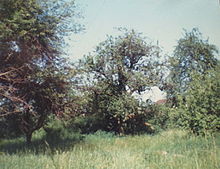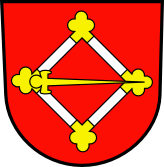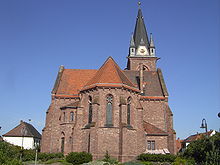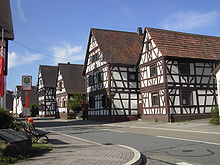Staff location
|
Staff location
City of Stutensee
|
|
|---|---|
| Coordinates: 49 ° 5 ′ 31 ″ N , 8 ° 30 ′ 41 ″ E | |
| Height : | 111 m above sea level NN |
| Residents : | 2011 (Sep 4, 2018) |
| Incorporation : | 1st January 1975 |
| Postal code : | 76297 |
| Area code : | 07249 |
Staffort is a small place between Karlsruhe and Bruchsal ; the long-established residents speak the South Franconian dialect . On January 1, 1975, Staffort was merged with the three neighboring towns of Blankenloch , Friedrichstal and Spöck to form the municipality of Stutensee , which was elevated to a major district town on January 1, 1998 .
Location and name
Staffort is 111 meters above sea level. NN on the Hardtrücken 10 km north of Karlsruhe and 10 km east of the Rhine . The alluvial soil was created by deposits during the floods of the Pfinz , Saalbach , Murg and Rhine. The tooth fossil of a Mammuthus primigenius (woolly-haired mammoth) found in Stafforter Gewann Gänsweide suggests that this part of the Hardt was inhabited by animals 90,000 years ago. The grand ducal land map from the beginning of the 20th century shows a maximum height difference of 17 feet for the Staffort district , which corresponds to a level difference of 5.10 meters. The soils of the Stafforter district are very different, they consist of 80% sand , 14.3% sandy loam and 5.7% loam or clay . The water table has the Rhine regulation by Tulla and Pfinz-Saalbach-correction lowered considerably (regional up to 2 meters); since then the spring floods that used to be common in some parts of the district have not occurred. Due to the Pfinzkanal dammed with a weir on the border to Spöck, the groundwater level is kept at 1.5 to 3 meters. The seasonal temperature profile is only slightly below that of the warmest region in Germany at the Kaiserstuhl (Baden) . The favorable climate and the steady or trudging ford through the Pfinz are likely to be the prerequisites for the early settlement or are the basis of the village name, the spelling of which has changed several times over the centuries: 1110 Stafphort, 1157 Staphurt, 1211 Staphord, 1213 Stafort, 1243 Staffurt, 1362 Staphurt, 1403 Staffert, 1418 Staffürd, 1424 Staffurth, 1669 Staffurt, 1743 Stafforth, since 1905 Staffort.
history
Staffort was first mentioned as "Stafphort" in a certificate from Emperor Heinrich V on August 16, 1110 . It can be assumed that as early as Roman times around 25 AD there was a Roman fort on the trade route from Hochstetten to the Roman station Stettfeld at the "constant ford ", the transition over the "Sumpfbach" (the Pfinz ) . At least four Roman plates with the pottery stamp JUCUNDUS and DOMINA -TUS FE were found here. The stone house of the "Knight of Staphurt" is likely to have been built on the foundation walls of this Roman fortification. In 1157, Ruedegerus de Staphurt was mentioned for the first time as a servant of the Bishop of Speyer . In 1377 Gerhard von Staphurt entered the service of the margrave of Baden as a servant. After several disputes between the Bishop of Speyer, King Ruprecht of the Palatinate and Margrave Bernhard I of Baden, the castle and village finally remained in Baden ownership from 1424.
The castle experienced its literary climax with the printing of the “Stafforter Buch” by the printer Bernhardt Albin in 1599. Margrave Ernst Friedrich von Baden-Durlach , from 1584 lord of the lower margraviate and Calvinist , presented a compendium of Reformed teaching . Through the so-called "White Regiment", which moved with 20,000 men in 1622 from the castle and village of Staffort on the side of the Protestants in the Thirty Years' War (1618-1648) and took part in the Battle of Mingolsheim , the Staffort rule was militarily significant for the last time.
Staffort Castle, surrounded by a moat, existed until August 19, 1689, when it was destroyed by Melac's troops in the Palatinate War of Succession . The blown up buildings on Schlossplatz were released for demolition. Over the centuries the masonry was removed and used for construction purposes in the Stutensee hunting lodge and the village of Staffort.
The Staffort church registers were re-created in 1669 by Pastor Johann Georg Zandt (Rev. 1668–1691) - older records were lost during the earlier "chaos of war". The recordings are continued and saved to this day without interruption. The first indication of a population is found in it in 1706 by Pastor Lindemann (Rev. 1692–1737); he wrote: "Staffurt has increased, 178 people who follow the Evangelical Lutheran religion are here".
Until the founding of the Grand Duchy of Baden in 1806, Staffort, which belonged to the margraviate of Baden-Durlach , was in the tri-border region with the Electoral Palatinate and the Speyer Monastery . A large number of former boundary stones from this period, such as B. State boundary stone, castle mark stone, Geleitstein, Erblehensstein, gilt stone, tithe stone and Gießbach cleaning stone are secured to this day.
The old boundary stones and the former municipal seal show a sester in the old local coat of arms. In 1895, the Staffort municipal council accepted the new coat of arms proposal from the Baden General State Archives:
The coat of arms in red has a silver buckle with gold fittings and a gold thorn.
The task of the heraldists to work out the deviation from the existing seals and border markings as little as possible, but clearly distinguish them from all other German coats of arms, seemed to have succeeded, especially since the Baden state colors were used and the belt buckle was a reference to the old stafforter Rule was included.
In the 18th and 19th centuries there were numerous emigrations; 73 people, some with wives or families, left the village for America , Denmark , Jutland , Prussia , Russia , Serbia , Styria , Hungary and West Prussia .
The following family names are entered in the Stafforter Bürgerbuch from 1837: Amolsch, Brauch, bothck, Dürr, Enderlin, Ernst, Gamer, Glaser, Hager, Hauck, Hauth, Hecht, Heidt, Kohler, Malsch, Maier, Mezger, Nagel, Oberacker, Raupp, Stahl, Stober, Schilling, Scholl, Schoppinger, Sickinger, Suss, Waidmann, Winnes.
In the First World War (1914–1918) the village had 31 dead, in the Second World War 1939–1945 50 dead. On the night of February 2 to 3, 1945, 65% of the village was destroyed by a British bomber fleet and 18 inhabitants were killed. The strong southwest winds had shifted the target markings for the bombing so that the bomb load that was supposed to hit the main train station in Karlsruhe fell on Staffort.
After the war, many refugee families found a new home in Staffort. A significant proportion of these came from Catholic Yugoslavia , so that the formerly purely Protestant community has since then had a significant Catholic population.
On January 1, 1975, Staffort came to the new community of Stutensee.
Since 2010 there has been a sponsorship between Staffort and the sixth company of the NBC Defense Battalion 750 "Baden" .
In 2010, the first mention of the village was celebrated 900 years ago with a series of events; Theresa Bock (born May 11, 2009 Karlsruhe) was welcomed by Mayor Klaus Demal and Mayor Ludwig-Wilhelm Heidt at the local council meeting on July 21, 2011 as the 2000th inhabitant of the Staffort district .
The Staffort pastors became known beyond the village
- Jakob Gottlieb Eisenlohr, Rev. 1746–1756; In 1748 he published the church history of the margraviate of Baden-Durlach
- Aloys Henhöfer , Rev. 1827–1862; he initiated a reformatory revival movement and founded several deaconess houses; the University of Heidelberg awarded him the title of Dr. hc
- Carl Lorenz Peter, Rev. 1863-1897; was Badischer Kirchenrat he continued the work of his predecessor and was particularly committed to the Inner Mission in Baden, the Grand Duke awarded him the Commander's Cross of the Order of Berthold
- Georg Urban, Rev. 1924–1951; as dean of the church district secured a lot of church history data for the Hardt region; Around the steeples of the Henhöfer parishes Spöck and Staffort, a chronicle about the years 1924-1951 Bretten 1968
- Holger Müller , Rev. since 2015, initiator and co-author of the church leader: Die Evangelische Kirche Staffort; A paradisiacal total work of art from neo-Gothic and Art Nouveau , Klotz Verlag Neulingen 2019, ISBN 978-3-948424-04-6
Attractions
Sights are the village square in the center, the historic half-timbered houses (Franconian architectural style), the village town hall, the Protestant church with the Christ tree by Hermann Weber , the war memorial and the border stone refuge at the cemetery and the natural monuments "Linden near the church" and "Oak" at the quarry pond ".
The "threshing hall", in which the threshing machine used to stand and the farmers could thresh their grain, was converted into a festival hall in the 1970s, but retained its external shape.
The only reminder of the former moated castle is the "Schlossbuckel" at the end of the village in the direction of Friedrichstal.
economy
Up until around 1950, agriculture in Staffort served as a source of self-sufficiency and main source of income for more than 90% of families. The village life and work community was the model of the village for centuries. The farm structure was therefore characterized by small farms, the predominant farm size in Staffort, as everywhere in Baden, was less than 2 hectares until the middle of the 20th century. In Staffort, 135 farms cultivated an area of 0.5–2 hectares, 95 farmers named between 2 ha and 5 ha of their property and only three farmers owned between 5 and 10 ha. Due to the small size of the company, the families were dependent on additional income. A special feature of Staffort was the widespread production of wooden shoes - which is what the traditional “Stafforter wooden shoe race” is reminiscent of.
In addition to livestock farming, the main source of income was the cultivation of tobacco , asparagus , potatoes , strawberries and medicinal plants . The Jerusalem artichoke , which is processed into “Stafforter Erdgold”, a schnapps , has had a special position for decades .
Today the area is cultivated by a few farmers with farm sizes of more than 50 hectares each. The main crops are winter wheat , winter rye , spring barley and maize .
There are no industrial or larger service companies in Staffort, the German Homeopathy Union operates a remarkable cultivation of medicinal plants, the majority of the working population is employed in the Karlsruhe Research Center and in industry and administration in the neighboring communities and Karlsruhe .
Personalities
- Johann Caspar Malsch (1673–1742) was a councilor in Baden and rector of the Illustre grammar school in Durlach .
- Johann Philipp Winne (1824-1874) was the third China - Missionaries of the Basel Mission .
- Karl Wilhelm Heidt (1871–1959) was a Reichsbahn official in Alsace and Durlach , after his retirement he returned to the village and was elected mayor . He waived the mayor's salary, imposed strict thriftiness on the village and was thus able to start building the new town hall - he was ousted from office during the Nazi era , but after the war he was appointed by the occupiers to be the mayor's administrator was the first honorary citizen (1951) of the village of Staffort.
- Dr. Ludwig Friedrich Mayer (1905–1950) was director and board member of the Raiffeisen Association Hesse in Kassel and member of the executive committee of the German Raiffeisen Association in Bonn .
- Dr. Friedrich Wilhelm Hauck (1921–2003) was a development worker in Africa and director of the Food and Agriculture Organization (FAO) in Rome , the UN agricultural organization .
- Hanna Heidt (* 1920) Stafforter Schwanenwirtin, long-time correspondent for the BNN , author of regional literature, poems and the Stafforter song for the 900th anniversary, founding chairwoman of the rural women’s association in Staffort and member of the board of the corresponding state association of Baden-Württemberg; Holder of the Federal Cross of Merit.
- Arnold Hauck (* 1928) farmer and last mayor of the village (1965–1975), then mayor of Stutensee-Staffort (1975–1985) and at the same time managing director of the Federal Association of German Tobacco Growers; Honorary citizen of the city of Stutensee.
- Philipp Heidt (1918–2001), Stafforter Mayor from 1985 to 1989.
- Heinrich Sickinger (* 1945), Mayor of Staffort 1989-2004
- Ludwig-Wilhelm Heidt (* 1951), Mayor of Staffort since 2004
Web links
- Staffort in the Stadtwiki Karlsruhe contains additional information on regional history as well as local associations and organizations
- City of Stutensee
literature
- Konrad Dussel : Staffort 1110 to 2010: Forays through 900 years of history . Verlag Regionalkultur Heidelberg, Ubstadt-Weiher, Basel 2010 ISBN 978-3-89735-622-1 .
- Wilhelm Hauck: Staffort - castle and village at the constant ford (local chronicle). Stutensee municipality 1993
- Arnold Hauck: Duwaggbreche in Stutensee . Stutensee Hefte, City of Stutensee 2003
- Hanna Heidt: memories of the past . Self-published, Schwanen Stutensee-Staffort 2003.
- Heiner Joswig : So ebbas . Stutensee-Hefte, Stadt Stutensee 2002, When our church stopped, Stadt Stutensee 2004 and Hengd a Engele an da Wan (d) Stadt Stutensee 2010 ISBN 978-3-9811869-3-2
- Jeff Klotz , Holger Müller: The Evangelical Church in Staffort, a paradisiacal total work of art from Neo-Gothic and Art Nouveau . Klotz Verlag, Neulingen 2019, ISBN 978-3-948424-04-6
- Manfred G. Raupp: What the grandfather already knew - thoughts on the development of agriculture in Staffort ; written in memory of Gustav W. Raupp (1905–1985). Self-published, Lörrach and Citizen's Office Stutensee-Staffort 2005; Local family book Staffort , published by the city of Stutensee, Verlag Gesowip Basel 2010, ISBN 978-3-906129-64-8
Individual evidence
- ↑ Stutensee figures and data ( memento of the original from August 17, 2011 in the Internet Archive ) Info: The archive link has been inserted automatically and has not yet been checked. Please check the original and archive link according to the instructions and then remove this notice.
- ^ Description of the Stafforter Schloss in the Stadtwiki Karlsruhe
- ^ Stafforter book in the Stadtwiki Karlsruhe
- ↑ The Stafforter book is digitized at Google Books
- ^ Federal Statistical Office (ed.): Historical municipality directory for the Federal Republic of Germany. Name, border and key number changes in municipalities, counties and administrative districts from May 27, 1970 to December 31, 1982 . W. Kohlhammer, Stuttgart / Mainz 1983, ISBN 3-17-003263-1 , p. 482 .
- ↑ Federal Armed Forces Operation in Kosovo Farewell in Staffort ( page no longer available , search in web archives ) Info: The link was automatically marked as defective. Please check the link according to the instructions and then remove this notice. (PDF; 84 kB)
- ↑ 900 years of Staffort
- ^ Minutes of the local council meeting on July 21, 2011
- ^ Heinrich Sickinger in the Stadtwiki Karlsruhe
- ^ Ludwig-Wilhelm Heidt in the Stadtwiki Karlsruhe
- ^ Wilhelm Hauck in the Stadtwiki Karlsruhe
- ^ Arnold Hauck in the Stadtwiki Karlsruhe
- ^ Heiner Joswig in the Stadtwiki Karlsruhe
- ^ Manfred G. Raupp in the Stadtwiki Karlsruhe




